Zishen Wan
Slm-mux: Orchestrating small language models for reasoning
Oct 06, 2025Abstract:With the rapid development of language models, the number of small language models (SLMs) has grown significantly. Although they do not achieve state-of-the-art accuracy, they are more efficient and often excel at specific tasks. This raises a natural question: can multiple SLMs be orchestrated into a system where each contributes effectively, achieving higher accuracy than any individual model? Existing orchestration methods have primarily targeted frontier models (e.g., GPT-4) and perform suboptimally when applied to SLMs. To address this gap, we propose a three-stage approach for orchestrating SLMs. First, we introduce SLM-MUX, a multi-model architecture that effectively coordinates multiple SLMs. Building on this, we develop two optimization strategies: (i) a model selection search that identifies the most complementary SLMs from a given pool, and (ii) test-time scaling tailored to SLM-MUX. Our approach delivers strong results: Compared to existing orchestration methods, our approach achieves up to 13.4% improvement on MATH, 8.8% on GPQA, and 7.0% on GSM8K. With just two SLMS, SLM-MUX outperforms Qwen 2.5 72B on GPQA and GSM8K, and matches its performance on MATH. We further provide theoretical analyses to substantiate the advantages of our method. In summary, we demonstrate that SLMs can be effectively orchestrated into more accurate and efficient systems through the proposed approach.
ANNIE: Be Careful of Your Robots
Sep 03, 2025Abstract:The integration of vision-language-action (VLA) models into embodied AI (EAI) robots is rapidly advancing their ability to perform complex, long-horizon tasks in humancentric environments. However, EAI systems introduce critical security risks: a compromised VLA model can directly translate adversarial perturbations on sensory input into unsafe physical actions. Traditional safety definitions and methodologies from the machine learning community are no longer sufficient. EAI systems raise new questions, such as what constitutes safety, how to measure it, and how to design effective attack and defense mechanisms in physically grounded, interactive settings. In this work, we present the first systematic study of adversarial safety attacks on embodied AI systems, grounded in ISO standards for human-robot interactions. We (1) formalize a principled taxonomy of safety violations (critical, dangerous, risky) based on physical constraints such as separation distance, velocity, and collision boundaries; (2) introduce ANNIEBench, a benchmark of nine safety-critical scenarios with 2,400 video-action sequences for evaluating embodied safety; and (3) ANNIE-Attack, a task-aware adversarial framework with an attack leader model that decomposes long-horizon goals into frame-level perturbations. Our evaluation across representative EAI models shows attack success rates exceeding 50% across all safety categories. We further demonstrate sparse and adaptive attack strategies and validate the real-world impact through physical robot experiments. These results expose a previously underexplored but highly consequential attack surface in embodied AI systems, highlighting the urgent need for security-driven defenses in the physical AI era. Code is available at https://github.com/RLCLab/Annie.
NSFlow: An End-to-End FPGA Framework with Scalable Dataflow Architecture for Neuro-Symbolic AI
Apr 29, 2025Abstract:Neuro-Symbolic AI (NSAI) is an emerging paradigm that integrates neural networks with symbolic reasoning to enhance the transparency, reasoning capabilities, and data efficiency of AI systems. Recent NSAI systems have gained traction due to their exceptional performance in reasoning tasks and human-AI collaborative scenarios. Despite these algorithmic advancements, executing NSAI tasks on existing hardware (e.g., CPUs, GPUs, TPUs) remains challenging, due to their heterogeneous computing kernels, high memory intensity, and unique memory access patterns. Moreover, current NSAI algorithms exhibit significant variation in operation types and scales, making them incompatible with existing ML accelerators. These challenges highlight the need for a versatile and flexible acceleration framework tailored to NSAI workloads. In this paper, we propose NSFlow, an FPGA-based acceleration framework designed to achieve high efficiency, scalability, and versatility across NSAI systems. NSFlow features a design architecture generator that identifies workload data dependencies and creates optimized dataflow architectures, as well as a reconfigurable array with flexible compute units, re-organizable memory, and mixed-precision capabilities. Evaluating across NSAI workloads, NSFlow achieves 31x speedup over Jetson TX2, more than 2x over GPU, 8x speedup over TPU-like systolic array, and more than 3x over Xilinx DPU. NSFlow also demonstrates enhanced scalability, with only 4x runtime increase when symbolic workloads scale by 150x. To the best of our knowledge, NSFlow is the first framework to enable real-time generalizable NSAI algorithms acceleration, demonstrating a promising solution for next-generation cognitive systems.
Generative AI in Embodied Systems: System-Level Analysis of Performance, Efficiency and Scalability
Apr 26, 2025Abstract:Embodied systems, where generative autonomous agents engage with the physical world through integrated perception, cognition, action, and advanced reasoning powered by large language models (LLMs), hold immense potential for addressing complex, long-horizon, multi-objective tasks in real-world environments. However, deploying these systems remains challenging due to prolonged runtime latency, limited scalability, and heightened sensitivity, leading to significant system inefficiencies. In this paper, we aim to understand the workload characteristics of embodied agent systems and explore optimization solutions. We systematically categorize these systems into four paradigms and conduct benchmarking studies to evaluate their task performance and system efficiency across various modules, agent scales, and embodied tasks. Our benchmarking studies uncover critical challenges, such as prolonged planning and communication latency, redundant agent interactions, complex low-level control mechanisms, memory inconsistencies, exploding prompt lengths, sensitivity to self-correction and execution, sharp declines in success rates, and reduced collaboration efficiency as agent numbers increase. Leveraging these profiling insights, we suggest system optimization strategies to improve the performance, efficiency, and scalability of embodied agents across different paradigms. This paper presents the first system-level analysis of embodied AI agents, and explores opportunities for advancing future embodied system design.
ADDT -- A Digital Twin Framework for Proactive Safety Validation in Autonomous Driving Systems
Apr 13, 2025Abstract:Autonomous driving systems continue to face safety-critical failures, often triggered by rare and unpredictable corner cases that evade conventional testing. We present the Autonomous Driving Digital Twin (ADDT) framework, a high-fidelity simulation platform designed to proactively identify hidden faults, evaluate real-time performance, and validate safety before deployment. ADDT combines realistic digital models of driving environments, vehicle dynamics, sensor behavior, and fault conditions to enable scalable, scenario-rich stress-testing under diverse and adverse conditions. It supports adaptive exploration of edge cases using reinforcement-driven techniques, uncovering failure modes that physical road testing often misses. By shifting from reactive debugging to proactive simulation-driven validation, ADDT enables a more rigorous and transparent approach to autonomous vehicle safety engineering. To accelerate adoption and facilitate industry-wide safety improvements, the entire ADDT framework has been released as open-source software, providing developers with an accessible and extensible tool for comprehensive safety testing at scale.
VAP: The Vulnerability-Adaptive Protection Paradigm Toward Reliable Autonomous Machines
Sep 30, 2024



Abstract:The next ubiquitous computing platform, following personal computers and smartphones, is poised to be inherently autonomous, encompassing technologies like drones, robots, and self-driving cars. Ensuring reliability for these autonomous machines is critical. However, current resiliency solutions make fundamental trade-offs between reliability and cost, resulting in significant overhead in performance, energy consumption, and chip area. This is due to the "one-size-fits-all" approach commonly used, where the same protection scheme is applied throughout the entire software computing stack. This paper presents the key insight that to achieve high protection coverage with minimal cost, we must leverage the inherent variations in robustness across different layers of the autonomous machine software stack. Specifically, we demonstrate that various nodes in this complex stack exhibit different levels of robustness against hardware faults. Our findings reveal that the front-end of an autonomous machine's software stack tends to be more robust, whereas the back-end is generally more vulnerable. Building on these inherent robustness differences, we propose a Vulnerability-Adaptive Protection (VAP) design paradigm. In this paradigm, the allocation of protection resources - whether spatially (e.g., through modular redundancy) or temporally (e.g., via re-execution) - is made inversely proportional to the inherent robustness of tasks or algorithms within the autonomous machine system. Experimental results show that VAP provides high protection coverage while maintaining low overhead in both autonomous vehicle and drone systems.
H3DFact: Heterogeneous 3D Integrated CIM for Factorization with Holographic Perceptual Representations
Apr 05, 2024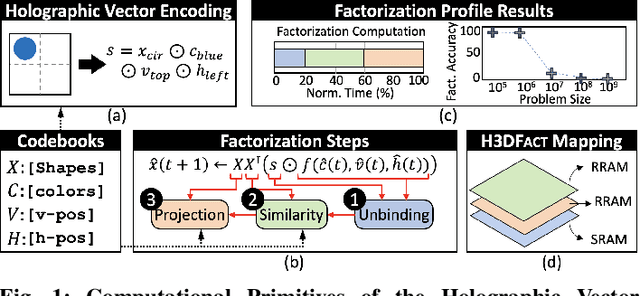

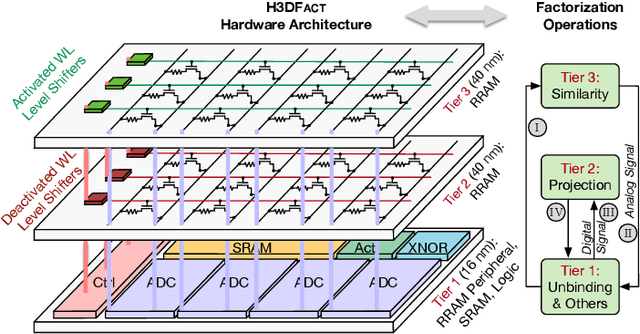
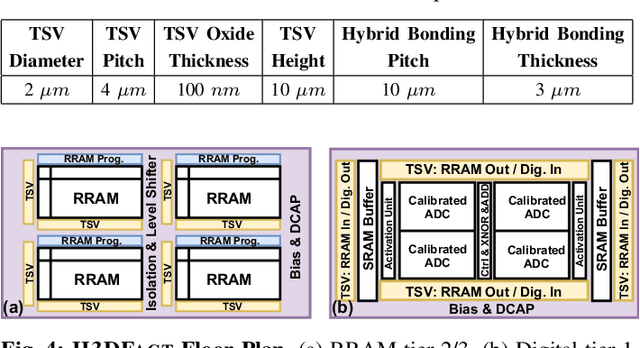
Abstract:Disentangling attributes of various sensory signals is central to human-like perception and reasoning and a critical task for higher-order cognitive and neuro-symbolic AI systems. An elegant approach to represent this intricate factorization is via high-dimensional holographic vectors drawing on brain-inspired vector symbolic architectures. However, holographic factorization involves iterative computation with high-dimensional matrix-vector multiplications and suffers from non-convergence problems. In this paper, we present H3DFact, a heterogeneous 3D integrated in-memory compute engine capable of efficiently factorizing high-dimensional holographic representations. H3DFact exploits the computation-in-superposition capability of holographic vectors and the intrinsic stochasticity associated with memristive-based 3D compute-in-memory. Evaluated on large-scale factorization and perceptual problems, H3DFact demonstrates superior capability in factorization accuracy and operational capacity by up to five orders of magnitude, with 5.5x compute density, 1.2x energy efficiency improvements, and 5.9x less silicon footprint compared to iso-capacity 2D designs.
Algorithm-Hardware Co-Design of Distribution-Aware Logarithmic-Posit Encodings for Efficient DNN Inference
Mar 08, 2024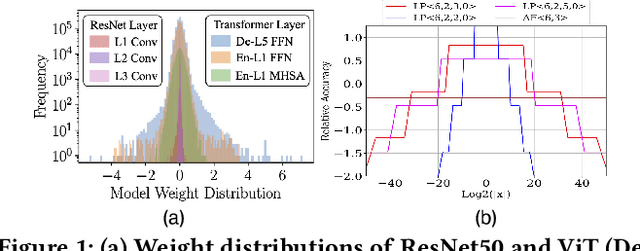

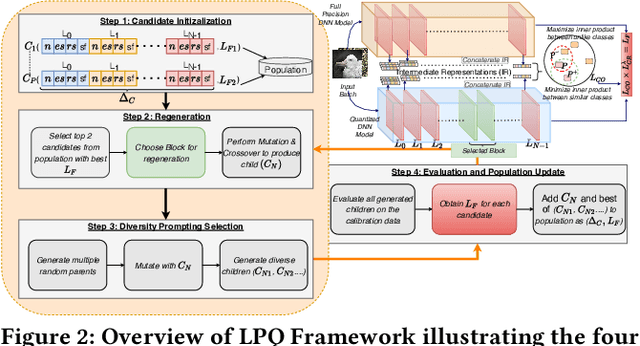

Abstract:Traditional Deep Neural Network (DNN) quantization methods using integer, fixed-point, or floating-point data types struggle to capture diverse DNN parameter distributions at low precision, and often require large silicon overhead and intensive quantization-aware training. In this study, we introduce Logarithmic Posits (LP), an adaptive, hardware-friendly data type inspired by posits that dynamically adapts to DNN weight/activation distributions by parameterizing LP bit fields. We also develop a novel genetic-algorithm based framework, LP Quantization (LPQ), to find optimal layer-wise LP parameters while reducing representational divergence between quantized and full-precision models through a novel global-local contrastive objective. Additionally, we design a unified mixed-precision LP accelerator (LPA) architecture comprising of processing elements (PEs) incorporating LP in the computational datapath. Our algorithm-hardware co-design demonstrates on average <1% drop in top-1 accuracy across various CNN and ViT models. It also achieves ~ 2x improvements in performance per unit area and 2.2x gains in energy efficiency compared to state-of-the-art quantization accelerators using different data types.
Towards Cognitive AI Systems: a Survey and Prospective on Neuro-Symbolic AI
Jan 02, 2024Abstract:The remarkable advancements in artificial intelligence (AI), primarily driven by deep neural networks, have significantly impacted various aspects of our lives. However, the current challenges surrounding unsustainable computational trajectories, limited robustness, and a lack of explainability call for the development of next-generation AI systems. Neuro-symbolic AI (NSAI) emerges as a promising paradigm, fusing neural, symbolic, and probabilistic approaches to enhance interpretability, robustness, and trustworthiness while facilitating learning from much less data. Recent NSAI systems have demonstrated great potential in collaborative human-AI scenarios with reasoning and cognitive capabilities. In this paper, we provide a systematic review of recent progress in NSAI and analyze the performance characteristics and computational operators of NSAI models. Furthermore, we discuss the challenges and potential future directions of NSAI from both system and architectural perspectives.
Scaling Compute Is Not All You Need for Adversarial Robustness
Dec 20, 2023Abstract:The last six years have witnessed significant progress in adversarially robust deep learning. As evidenced by the CIFAR-10 dataset category in RobustBench benchmark, the accuracy under $\ell_\infty$ adversarial perturbations improved from 44\% in \citet{Madry2018Towards} to 71\% in \citet{peng2023robust}. Although impressive, existing state-of-the-art is still far from satisfactory. It is further observed that best-performing models are often very large models adversarially trained by industrial labs with significant computational budgets. In this paper, we aim to understand: ``how much longer can computing power drive adversarial robustness advances?" To answer this question, we derive \emph{scaling laws for adversarial robustness} which can be extrapolated in the future to provide an estimate of how much cost we would need to pay to reach a desired level of robustness. We show that increasing the FLOPs needed for adversarial training does not bring as much advantage as it does for standard training in terms of performance improvements. Moreover, we find that some of the top-performing techniques are difficult to exactly reproduce, suggesting that they are not robust enough for minor changes in the training setup. Our analysis also uncovers potentially worthwhile directions to pursue in future research. Finally, we make our benchmarking framework (built on top of \texttt{timm}~\citep{rw2019timm}) publicly available to facilitate future analysis in efficient robust deep learning.
 Add to Chrome
Add to Chrome Add to Firefox
Add to Firefox Add to Edge
Add to Edge